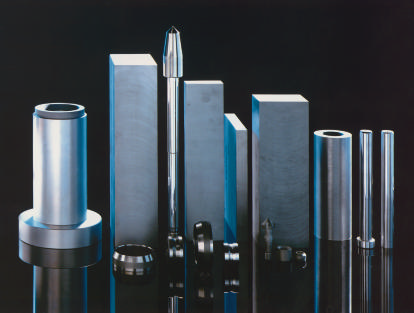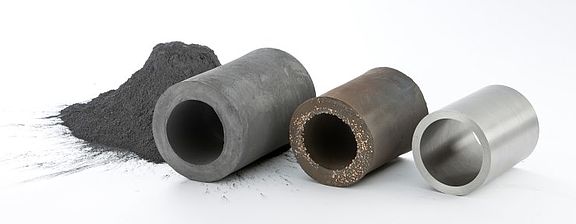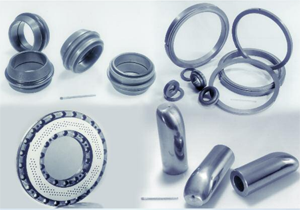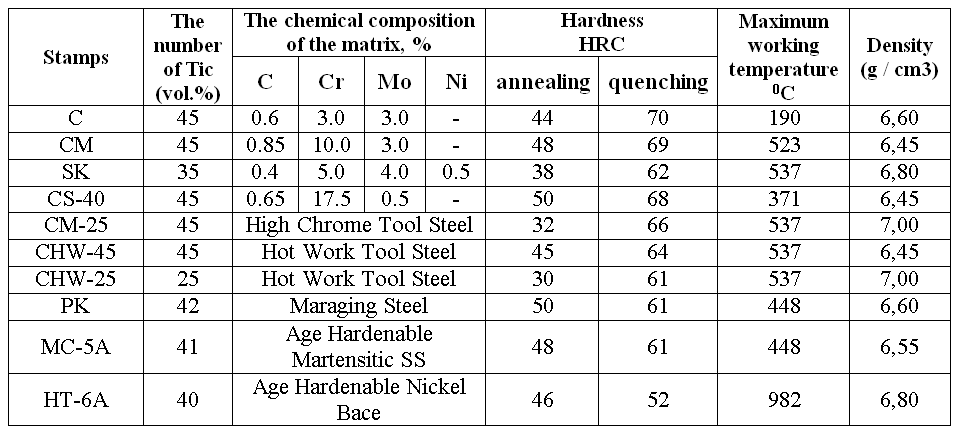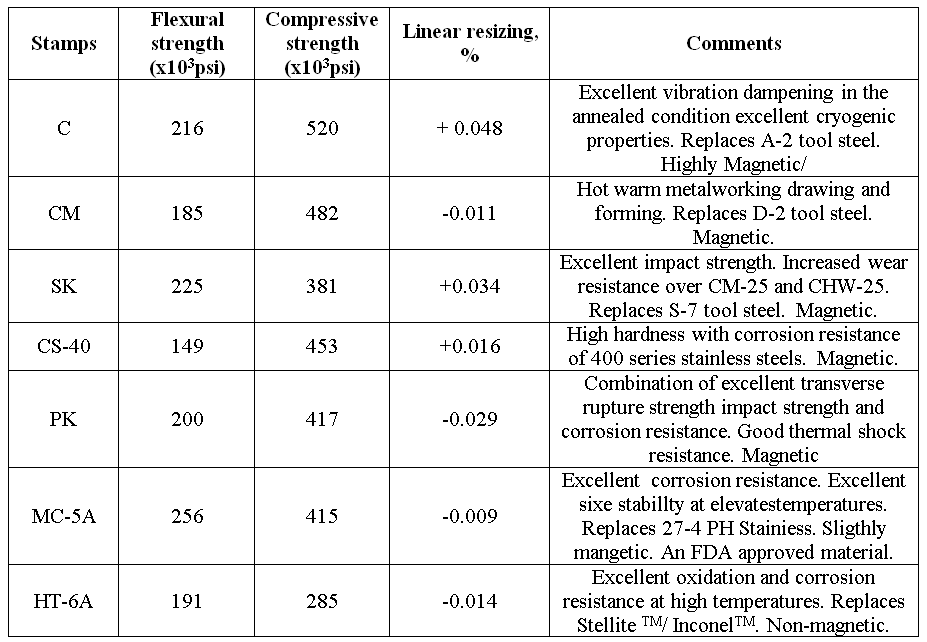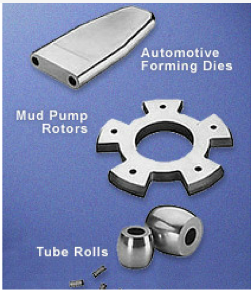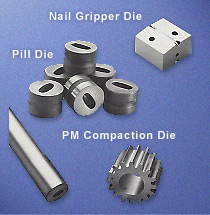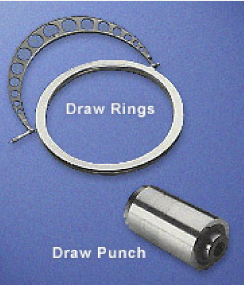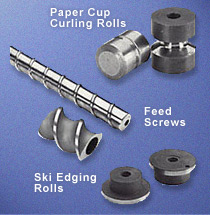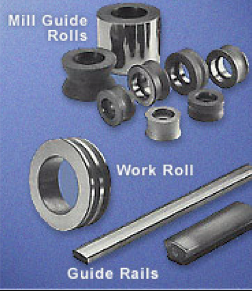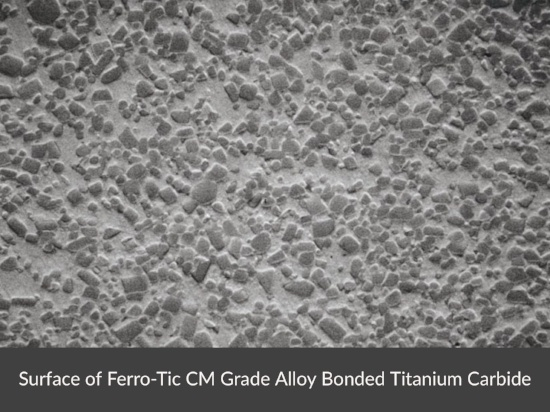The presented materials are taken from the official sites of foreign producers of carbidesteel.
1.Ferro-Titanit® is a trademark for a composite material manufactured in Germany by DEUTCHE EDELSTAHLWERKE GMBH in Krefeld, part of the SCHMOLZ + BICKENBACH Group.
https://www.ferro-titanit.de
https://www.dew-stahl.com/fileadmin/files/dew-stahl.com/documents/Publikationen/Broschueren/028_DEW_FerTit_Pulvermetallur_GB.pdf
The growing requirements for tools or machine components increasingly require the properties of materials that can only be satisfied with metal matrix composites. Ferro-Titanit® is a brand of the Deutsche Edelstahlwerke concern for powder metallurgical high-alloyed composites. The materials combine the properties of steel and carbide, which makes it possible to have high wear resistance.
The Ferro-Titanit® structure contains about 45% by volume of titanium carbide embedded in the bonded phase of alloyed steel. Upon delivery, this solid material can be processed by any method of machining. And hardening (up to 69 HRC) makes Ferro-Titanit® an economical option for solving many technical issues with durability. Tools have an extremely long service life, which allows significant savings on quantitative indicators. A longer machine run time results in lower costs for downtime for tool replacement equipment.
Ferro-Titanit® can be hardened with very small changes in linear dimensions, since titanium carbide has minimal thermal expansion and no deformation (leash). In addition, as a result of manufacturing, the structure of the powder does not have segregation and delamination. Hardening should be carried out in a vacuum, otherwise the negative effects of the oxidizing air environment will require an increase in the allowance of parts.
Ferro-Titanit® offers good opportunities for combination with steel and can be combined with composite sintering and composite brazing (bimetallic billets). When combined, Ferro-Titanit® is used in places that are highly susceptible to wear. Steel used as a substrate, saves on material, provides greater impact strength and provides cost-effective processing.
Ferro-Titanit® allows you to reuse worn tools. Worn tools and wear parts can be annealed many times and converted into new parts (without changing the structure). Just a small processing in a fully annealed condition will quickly allow you to replace a faulty tool or a wearing part.
Ferro-Titanit® can be processed in accordance with existing processing methods. In the annealed condition, it can be processed by conventional methods, such as turning, planing, milling, drilling, etc. You can simplify the work of the production department, allowing you to produce durable tools at a relatively low cost.
Ferro-Titanit® has minimal adhesion. Titanium carbides in Ferro-Titanit® (45% by volume) do not fuse with other materials. Low sticking, which is barely noticeable on well-polished tools and high wear resistance, leads to high tool resources with optimum surface quality.
Ferro-Titanit® has a low specific gravity. It is 50% lighter than hard alloys and 15% lighter than steel. This gives an advantage in design and work in high centrifugal forces.
Further information about Ferro-Titanit® can be found at www.ferro-titanit.de.
The chemical composition, mechanical properties, the scope of application are shown in tables 1.2.
Table 1. Chemical composition of FERRO-TITANIT
Table 2. Mechanical properties
FERRO-TITANIT blanks
FERRO-TITANIT Finished Products
Microstructure FERRO-TITANIT
- Ferro-TiC® is a trademark of a composite material, manufactured in the USA by Ferro-TIC SBC, PSM Industries, Inc.
www.ferro-tic.com
https://www.psmindustries.com/ferro-tic/
Ferro-TiC®: a family of steel or alloyed carbides. Extremely hard titanium carbide grains are evenly distributed in a quenched metal matrix. The result is a unique combination of high wear resistance, resistance to heat and corrosion and is easy to process by traditional methods.
Why titanium carbide?
Titanium carbide exceeds conventional tool steels 10 times, at the same time, providing a much better fracture toughness than hard alloys. In the annealed condition, these unique materials can be machined with conventional machining methods such as turning, milling and drilling. In the heat-treated state, they can reach a hardness of HRC 69.
Ferro-TiC® are manufactured using advanced powder metallurgy technologies. Unlike hard alloys, Ferro-TiC® is connected to hardened steel dies.
The rounded particles of titanium carbide (TiC) located on the surface of these materials provide a combination of low friction coefficient and hardness, since the hardness of titanium carbide is 30% higher than that of tungsten carbide. This unique combination makes TiC-materials with steel bonds particularly suitable for wear-resistant applications.
Industrial Applications for Ferro-Tic®
For tools, Ferro-TiC® provides a longer service life between sharpening. For drawing or forming tools, guides or rollers, rounded grains of titanium carbide on the surface provide lubricity and abrasion resistance not available in other tool materials. For wear or machine parts or for gauges, durability and ease of fabrication, in addition to their durability, make it easy to turn on and make it ideal for enhancing critical wear parts.
Universal Ferro-Tic® may be what you want. Slippery. Solid. Magnetic or Non-Magnetic. It can be used at cryogenic or elevated temperatures. For performance that demonstrates excellent resistance to abrasion, vibration, corrosion and thermal wear, there is a brand Ferro-TiC® that meets your needs.
Ferro-Tic Unique features
– Ferro-Tic provides light weight, size, stability and hardness.
– Ferro-Tic is practically porous much better, A1 standard ASTM B-276-79.
– Low specific gravity. Ferro-Tic is 10–20% lighter than its steel counterpart, and about 50% lighter than hard alloys.
– 10-fold wear resistance in comparison with tool steels.
– Cost-effective manufacturing
– Traditionally processed at the annealing stage by milling, turning, etc.
– Traditionally heat treated to achieve high hardness.
– 50-90% less linear size change during heat treatment than tool steels.
Further information about Ferro-TiC® can be found at https://www.psmindustries.com/ferro-tic
The chemical composition, mechanical properties of Ferro Tic® are listed in Tables 3.4.
The property tables below provide technical data for many existing Ferro Tic® brands. Some may have excellent thermal shock resistance. Some of them are magnetic, some are non-magnetic. Some work in cryogenic conditions.
Table 3. – Chemical composition
Table 4.-Mechanical properties, scope
Ferro Tic® Finished Products



